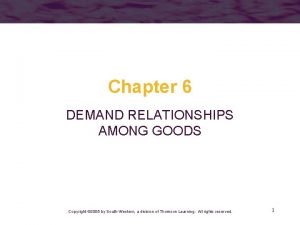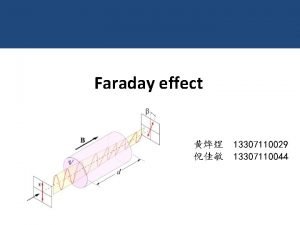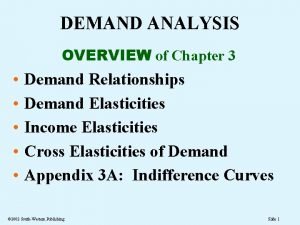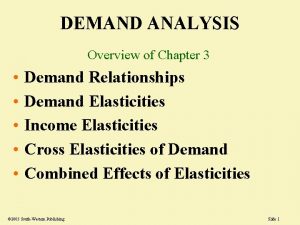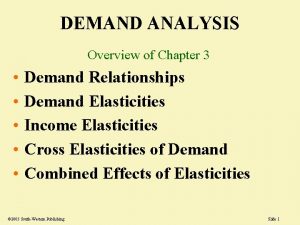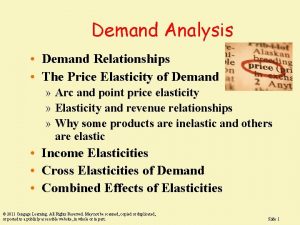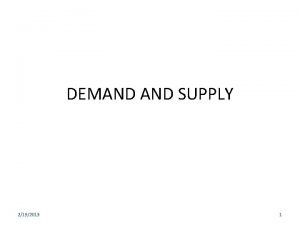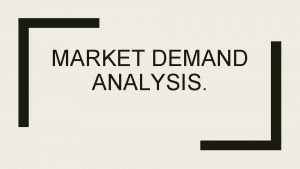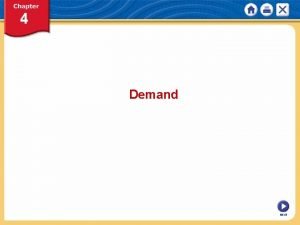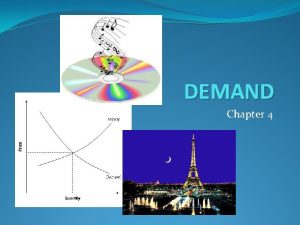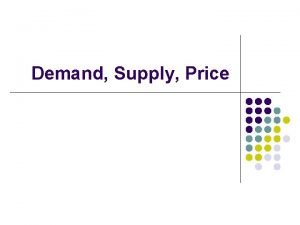DEMAND ANALYSIS Overview of Chapter 3 Demand Relationships


























- Slides: 26

DEMAND ANALYSIS Overview of Chapter 3 • Demand Relationships • The Price Elasticity of Demand » Arc and point price elasticity » Elasticity and revenue relationships » Why some products are inelastic and others are elastic • Income Elasticities • Cross Elasticities of Demand • Combined Effects of Elasticities © 2008 Thomson * South-Western Slide 1

Health Care & Cigarettes • Raising cigarette taxes reduces smoking » In Canada, over $4 for a pack of cigarettes reduced smoking 38% in a decade • But cigarette taxes also helps fund health care initiatives » The issue then, should we find a tax rate that maximizes tax revenues? » Or a tax rate that reduces smoking? Slide 2

Demand Analysis • An important contributor to firm risk arises from sudden shifts in demand for the product or service. • Demand analysis serves two managerial objectives: (1) it provides the insights necessary for effective management of demand, and (2) it aids in forecasting sales and revenues. Slide 3

Downward Slope to the Demand Curve • Economists presume consumers are maximizing their utility • This is used to derive a demand curve from utility maximization • Reasons that price and quantity are negatively related include: » income effect -- as the price of a good declines, the consumer can purchase more of all goods since his or her real income increased. So as the price falls, we typically buy more. » substitution effect -- as the price declines, the good becomes relatively cheaper. A rational consumer maximizes satisfaction by reorganizing consumption until the marginal utility in each good per dollar is equal. We buy more. Slide 4

Uo Food PE Indifference Curves to U 1 derive demand • We can "derive" a demand curve graphically from maximization of utility a c b subject to a budget 2 constraint. Suppose the price of entertainment falls 1 Entertainment from line 1 to line 2 • We tend to buy more from (i) the Income Effect and (ii) the Substitution Effect. demand From a to b, is the Entertainment substitution effect. From b to c is the income effect. Slide 5

The Price Elasticity of Demand • Elasticity is measure of responsiveness or sensitivity • Beware of using Slopes price per bu. bushels Slopes change with a change in units of measure hundred tons Slide 6

Price Elasticity • ED = % change in Q / % change in P • Shortcut notation: ED = % Q / % P • A percentage change from 100 to 150 is 50% • A percentage change from 150 to 100 is -33% • For arc price elasticities, we use the average as the base, as in 100 to 150 is +50/125 = 40%, and 150 to 100 is -40% • Arc Price Elasticity -- averages over the two points Average quantity ED = Q/ [(Q 1 + Q 2)/2] P/ [(P 1 + P 2)/2] arc price elasticity D Average price Slide 7

Arc Price Elasticity Example • • Q = 1000 when the price is $10 Q= 1200 when the price is reduced to $6 Find the arc price elasticity Solution: ED = % Q/ % P = +200/1100 -4/8 or -. 3636. The answer is a number. A 1% increase in price reduces quantity by. 36 percent. Slide 8

Point Price Elasticity Example • Need a demand curve or demand function to find the price elasticity at a point. ED = % Q/ % P =( Q/ P)(P/Q) If Q = 500 - 5 • P, find the point price elasticity at P = 30; P = 50; and P = 80 1. ED = ( Q/ P)(P/Q) = - 5(30/350) = -. 43 2. ED = ( Q/ P)(P/Q) = - 5(50/250) = - 1. 0 3. ED = ( Q/ P)(P/Q) = - 5(80/100) = - 4. 0 Slide 9

Price Elasticity (both point price and arc elasticity ) • If ED = -1, unit elastic • If ED > -1, inelastic, e. g. , - 0. 43 • If ED < -1, elastic, e. g. , -4. 0 price elastic region unit elastic Straight line demand curve example inelastic region quantity Slide 10

Two Extreme Examples ( Figure 3. 1) D D D’ D’ Perfectly Elastic | ED| = B and Perfectly Inelastic |ED | = 0 Slide 11

TR and Price Elasticities • If you raise price, does TR rise? • Suppose demand is elastic, and raise price. TR = P • Q, so, % TR = % P+ % Q • If elastic, P , but Q a lot • Hence TR FALLS !!! • Suppose demand is inelastic, and we decide to raise price. What happens to TR and TC and profit? Slide 12

( Figure 3. 2) Another Way to Remember • • • Linear demand curve TR on other curve Look at arrows to see movement in TR A. Increasing price in the inelastic region raises revenue B. Increasing price in the elastic region lowers revenue Elastic Unit Elastic A Inelastic B Q TR Q Slide 13

MR and Elasticity • Marginal revenue is TR / Q • To sell more, often price must decline, so MR is often less than the price. à MR = P ( 1 + 1/ED ) equation 3. 7 on page 90 • For a perfectly elastic demand, ED = -B. Hence, MR = P. • If ED = -2, then MR =. 5 • P, or is half of the price. Slide 14

1979 Deregulation of Airfares • • Prices declined after deregulation And passengers increased Also total revenue increased What does this imply about the price elasticity of air travel? » It must be that air travel was elastic, as a price decrease after deregulation led to greater total revenue for the airlines. Slide 15

Determinants of the Price Elasticity • The availability and the closeness of substitutes » more substitutes, more elastic • The more durable is the product » Durable goods are more elastic than non-durables • The percentage of the budget » larger proportion of the budget, more elastic • The longer the time period permitted » more time, generally, more elastic » consider examples of business travel versus vacation travel for all three above. Slide 16

Empirical Price Elasticities Table 3. 5 • • Apparel (whole market) -1. 1 Apparel (one firm) -4. 1 Beer -. 84 Wine -. 55 Liquor -. 50 Regular coffee -. 16 Instant coffee -. 36 Adult visits to dentist » men -. 65 » Women -. 78 • Children visit to dentist -1. 4 • • • Furniture -3. 04 Glassware & China -1. 2 School lunches -. 47 Flights to Europe -1. 25 Shoes -. 73 Soybean meal -1. 65 Telephones -. 10 Tires -. 60 Tobacco -. 46 Tomatoes -2. 22 Wool -1. 32 Slide 17

Free Trade and Price Elasticities • NAFTA (North American Free Trade Agreement) and Europe having a common currency in the Euro are examples of greater freedom in trade • What does that do to price elasticities? • With more substitutes, we expect that products become More Elastic • Consumers gain as firms are less able to raise their prices, but firm face stiffer competition Slide 18

Income Elasticity EY = % Q/ % Y = ( Q/ Y)( Y/Q) point income EY = Q/ [(Q 1 + Q 2)/2] arc income Y/ [(Y 1 + Y 2)/2] elasticity • arc income elasticity: » suppose dollar quantity of food expenditures of families of $20, 000 is $5, 200; and food expenditures rises to $6, 760 for families earning $30, 000. » Find the income elasticity of food » % Q/ % Y = (1560/5980) • (10, 000/25, 000) =. 652 » With a 1% increase in income, food purchases rise. 652% Slide 19

Income Elasticity Definitions • If EY >0, then it is a normal or income superior good » some goods are Luxuries: EY > 1 with a high income elasticity » some goods are Necessities: EY < 1 with a low income elasticity • • If EY is negative, then it’s an inferior good Consider these examples: 1. Expenditures on new automobiles 2. Expenditures on new Chevrolets 3. Expenditures on 1996 Chevy Cavaliers with 150, 000 miles Which of the above is likely to have the largest income elasticity? Which of the above might have a negative income elasticity? Slide 20

Point Income Elasticity Problem • Suppose the demand function is: Q = 10 - 2 • P + 3 • Y • find the income and price elasticities at a price of P = 2, and income Y = 10 • So: Q = 10 -2(2) + 3(10) = 36 • EY = ( Q/ Y)( Y/Q) = 3( 10/ 36) =. 833 • ED = ( Q/ P)(P/Q) = -2(2/ 36) = -. 111 • Characterize this demand curve, which means describe them using elasticity terms. Slide 21

Cross Price Elasticities EX = % QA / % PB = ( QA/ PB)(PB /QA) • Substitutes have positive cross price elasticities: Butter & Margarine • Complements have negative cross price elasticities: DVD machines and the rental price of DVDs at Blockbuster • When the cross price elasticity is zero or insignificant, the products are not related Slide 22

PROBLEM: Find the point price elasticity, the point income elasticity, and the point cross-price elasticity at P=10, Y=20, and Ps=9, if the demand function were estimated to be: QD = 90 - 8·P + 2·Y + 2·Ps Is the demand for this product elastic or inelastic? Is it a luxury or a necessity? Does this product have a close substitute or complement? Find the point elasticities of demand. Slide 23

Answer • First find the quantity at these prices and income: QD = 90 - 8·P + 2·Y + 2·Ps = 90 -8· 10 + 2· 20 + 2· 9 =90 -80 +40 +18 = 68 • ED = ( Q/ P)(P/Q) = (-8)(10/68)= -1. 17 which is elastic • EY = ( Q/ Y)(Y/Q) = (2)(20/68) = +. 59 which is a normal good, but a necessity • EX = ( QA/ PB)(PB /QA) = (2)(9/68) = +. 26 which is a mild substitute Slide 24

Combined Effect of Demand Elasticities • Most managers find that prices and income change every year. The combined effect of several changes are additive. % Q = ED(% P) + EY(% Y) + EX(% PR) » where P is price, Y is income, and PR is the price of a related good. • If you knew the price, income, and cross price elasticities, then you can forecast the percentage changes in quantity. Slide 25

Example: Combined Effects of Elasticities • Toro has a price elasticity of -2 for snow-throwers • Toro snow throwers have an income elasticity of 1. 5 • The cross price elasticity with professional snow removal for residential properties is +. 50 • What will happen to the quantity sold if you raise price 3%, income rises 2%, and professional snow removal companies raises its price 1%? » % Q = EP • % P +EY • % Y + EX • % Px = -2 • 3% + 1. 5 • 2% +. 50 • 1% = -6% + 3% +. 5% » % Q = -2. 5%. We expect sales to decline 2. 5%. Q: Will Total Revenue for your product rise or fall? A: Total revenue will rise slightly (about +. 5%), as the price rises 3% and the quantity of snow-throwers sold falls 2. 5%. Slide 26
 Chapter 1 overview of financial statement analysis
Chapter 1 overview of financial statement analysis Demand relationships among goods
Demand relationships among goods A 23 year old male experienced severe head trauma
A 23 year old male experienced severe head trauma Chapter 14 medical overview
Chapter 14 medical overview Chapter 9 lesson 2 photosynthesis an overview
Chapter 9 lesson 2 photosynthesis an overview Chapter 12 selling overview
Chapter 12 selling overview Financial intermediaries
Financial intermediaries Chapter 1 overview of verb tenses
Chapter 1 overview of verb tenses Overview of personal finance chapter 1
Overview of personal finance chapter 1 Tooth numbering system in usa
Tooth numbering system in usa Introduction to personal finance chapter 1 answers
Introduction to personal finance chapter 1 answers General features of animals
General features of animals Chapter 1 an overview of financial management
Chapter 1 an overview of financial management Chapter 17 overview elements and their properties
Chapter 17 overview elements and their properties Stochastic inventory model example
Stochastic inventory model example Measures to correct excess demand and deficient demand
Measures to correct excess demand and deficient demand Individual demand vs market demand
Individual demand vs market demand Dependent and independent demand example
Dependent and independent demand example Example ng demand function
Example ng demand function Dependent demand examples
Dependent demand examples Module 5 supply and demand introduction and demand
Module 5 supply and demand introduction and demand Methods of demand estimation in managerial economics
Methods of demand estimation in managerial economics Paradox of value
Paradox of value Independent demand
Independent demand Angle relationships error analysis
Angle relationships error analysis Chapter 7 family relationships
Chapter 7 family relationships Chapter 8 peer relationships answer key
Chapter 8 peer relationships answer key

